Where does your wood come from? You might be surprised.
- Tags:
- Education,
- Working Forests
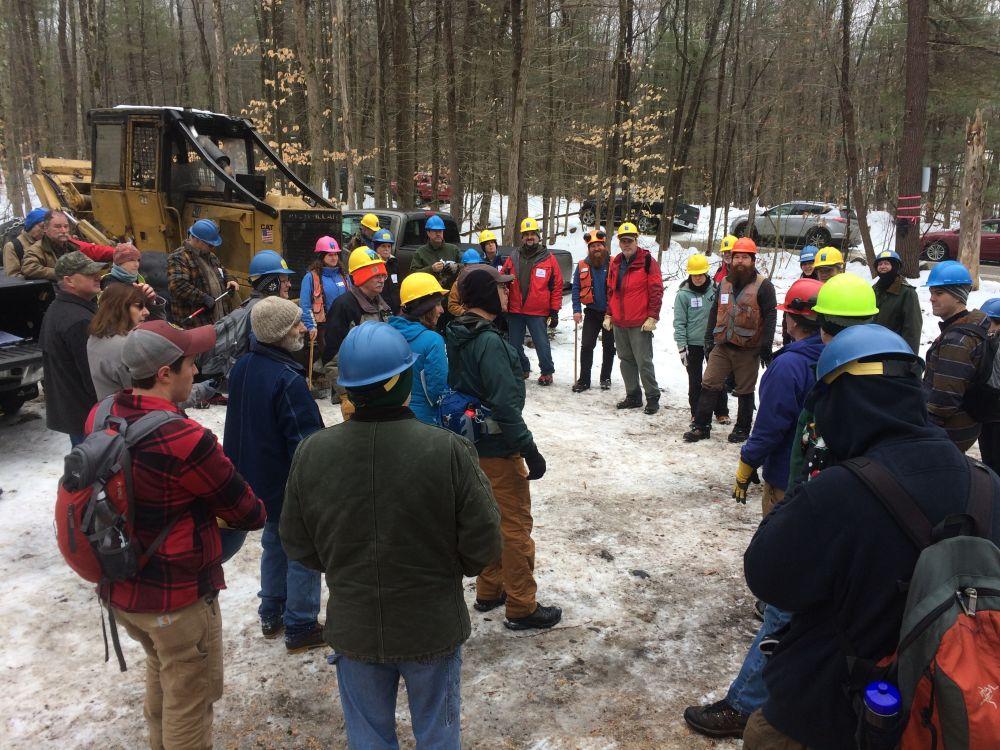
Recent tour of timber harvest at Forest Society Gap Mountain Forest Reservation in Troy, NH. Photo Rebecca DiGirolomo
You’ve seen slogans on pick-up truck bumpers or wood chip trailers: “Got Wood?” or “Local Wood, Local Good.” You don’t think twice about trucks on NH highways hauling logs heading for sawmills or tractor trailer loads of wood chips destined to generate electricity. These are familiar sights in New Hampshire. But have you ever toured an active logging job with the managing foresters and a logger?
In winter, the Forest Society hosts education tours on our Forest Reservations where logging is taking place. People may wonder why we’d invite neighbors and even potential critics to see nitty-gritty logging that creates change and often brings temporary visual chaos – log piles, cut stumps, tangled limbs and slash.
The challenge forestland owners and managers face is that people are unaccustomed to the scale of change or noise when skidders are pulling logs as loggers cut trees, leaving behind “slash” of non-merchantable tops. It seems so disruptive. We’re visual creatures. We tend to think in the present tense. People view even a temporary disturbance to otherwise quiet forests negatively. Foresters are trained to manage woodlands for longer time frames - decades. A timber harvest can regenerate young trees and provide greater wildlife habitat diversity.
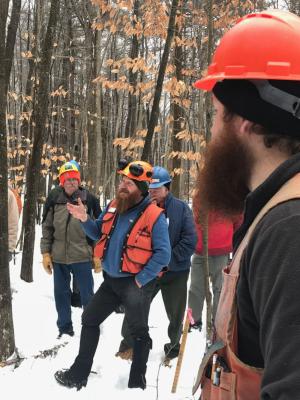
Two things people are uncomfortable with: change and mess. There is no way to “thin the garden” of low quality “weed trees” while harvesting some of the higher quality saw-logs without creating a bit of both. We sponsor guided tours of active logging jobs so people have opportunities to learn what they may perceive as disruptive is not necessarily destructive. We’re proud of the planning, professionalism and skill demonstrated by our staff foresters, private consulting foresters and loggers working on Forest Society land.
Cheshire County Forester, Steve Roberge and consulting forester, Eric Radlof of Bay State Forestry helped host a recent tour at the Gap Mountain Forest Reservation in Troy. Radlof explains “I’m a fan of getting the public out into the woods on an active harvest. It gives people the chance to see and understand what is going on. It also allows the public to ask questions and help with any misconceptions they might have. Forestry education reconnects the public to where their forest products come from. There is a misconception that forest products come from a distant land, but in reality much of the harvesting that we see within our neighborhood, town, or county contributes directly to the forest products that we use.”
Let's start at the beginning
Just off the paved, public road is a log landing where saw logs awaiting trucking are sorted into a range of different grades. But that’s where our timber harvest story ends. We’d better start at the beginning…
We hike uphill, away from the landing to the back of the job where harvest boundaries and trees yet to be cut are delineated by blue paint squirted from a forester’s paint gun onto tree stems. Future “crop trees” are flagged with pink ribbon so loggers develop an eye for trees the forester is attempting to favor and “release” by removing competing trees. A glimpse of “before harvest” conditions provides a nice contrast to areas that are being logged – either weeded and thinned or by creating larger sunny openings for regeneration of sun-loving trees: white birch, white pine and red oak for timber or aspen with fruiting shrubs for enhanced wildlife food.
Forest Society foresters describe how our property-specific management plans include goals for the future forest and also goals for protecting non-timber values including wildlife habitats, recreation trails, scenic vistas and designated ecological reserves. Timber harvests employ “best management practices” to protect water quality, wetlands, steep slopes, fragile areas and cultural and historical resources including stonewalls and the cellars of former farms.
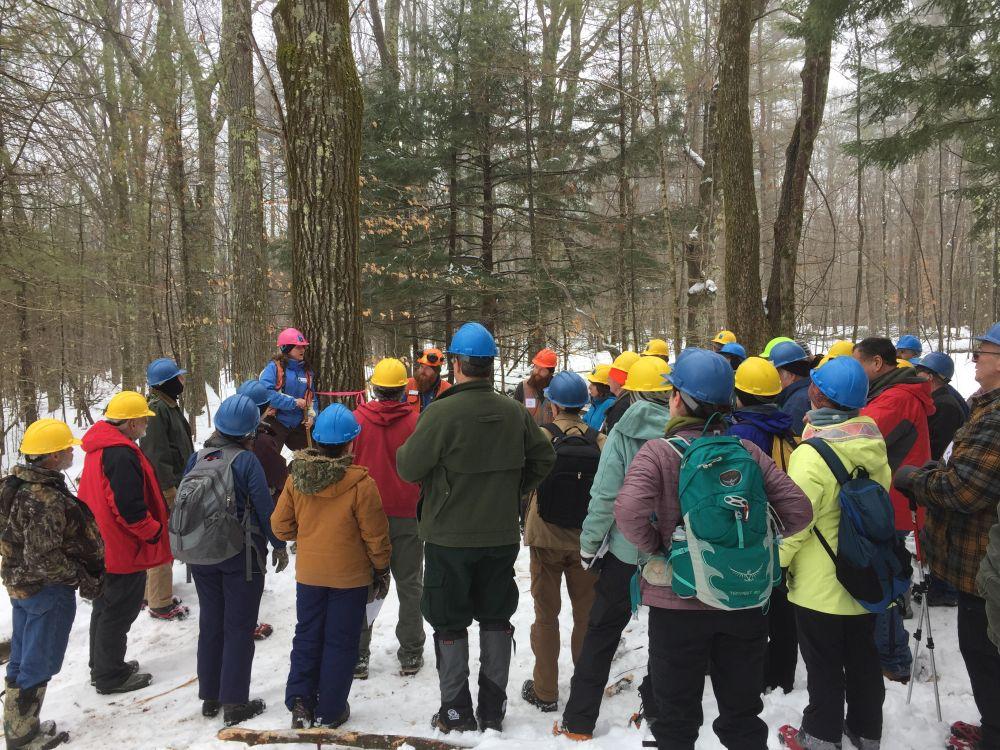
What’s that tree worth?
On the tour, we like to “sell” a tall, straight red oak by opening bidding at $25 and trying to push upwards of $100. Bidders get timid as the price increases. Foresters measure the timber volume with a “Biltmore stick” to provide an estimate of the board feet contained in the stem. We apply a current range of “stumpage” prices to arrive at an estimate of the dollar value for the tree where it stands in the woods. It’s often less than participants bid! The auction experience creates the opportunity to explain volume and value as well as the respective roles of landowner, consulting forester and logger - and how each are paid.
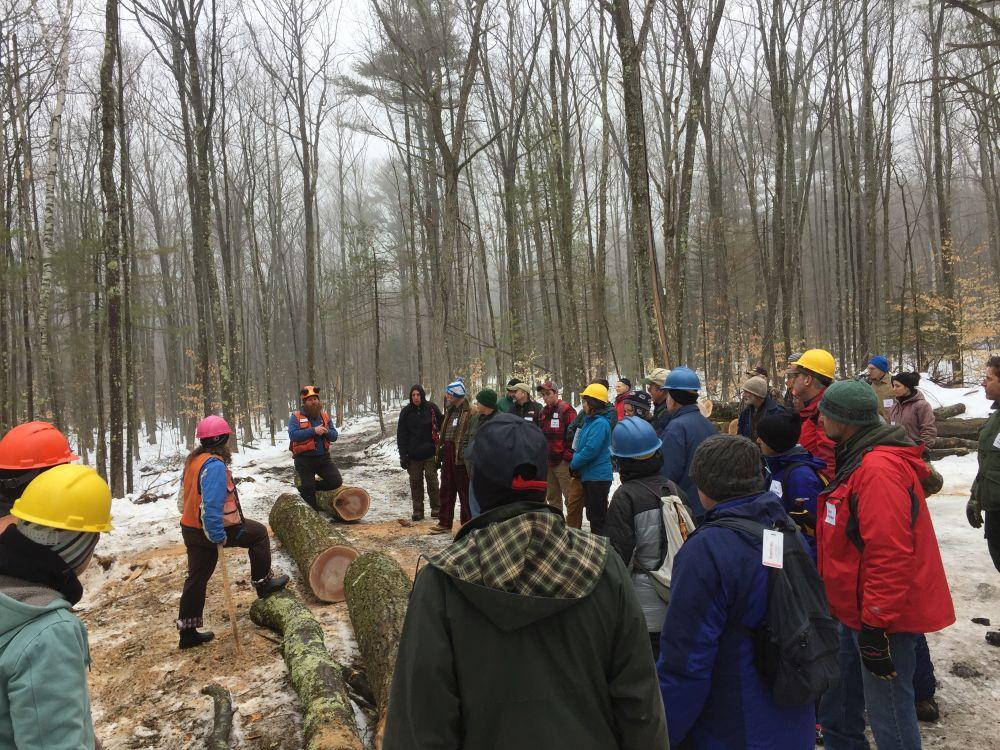
Back on the landing where logs are sorted by species and grade, talk turns to wood markets – the higher price paid once a tree is cut down, skidded and bucked into merchantable lengths. Log prices reflect the species, volume and quality. Different units of measurement vary with products produced: fuelwood chips by the ton for biomass energy markets, hardwood and softwood pulp by the cord for fuelwood and paper industries, and the higher quality hardwood or softwood saw logs by thousand board feet for lumber.
Wood markets are complex. Merchandizing logs on the landing – cutting each tree to its highest value product - is where the role of available markets becomes most tangible. On some jobs, low value trees are sorted into piles to be chipped for biomass energy markets, pulp trees are set aside for trucking to pulp mills or for firewood and the highest quality saw logs are sorted to serve a range of specialty products: lumber for framing, millwork or flooring and even white ash for tool handles or red oak veneer for high-end furniture or flooring.
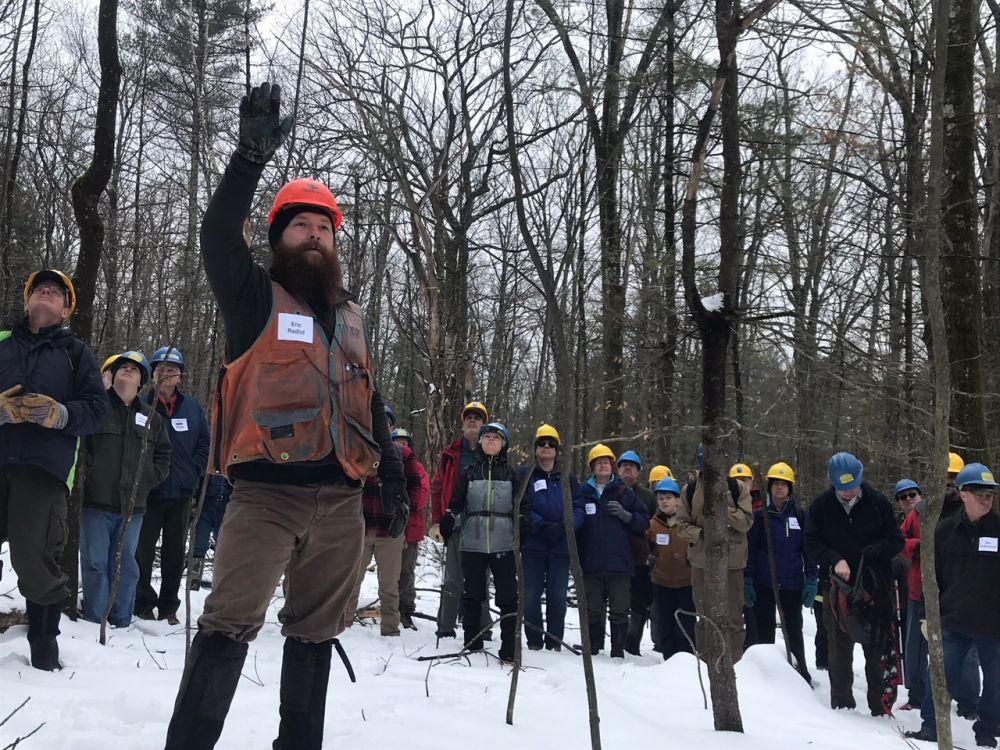
In addition to skillful merchandizing of logs by the logger, foresters and loggers cooperate to arrange for trucking wood to reach various mills throughout New Hampshire, Maine, Vermont and New York. Loads average 6,000 board feet per truck as saw logs, 30 tons of chips per tractor trailer load of chips and 20 tons of pulp logs per truckload. Truckload figures help people to better visualize wood volume on the landing or traveling the highways.
On the Gap Mountain timber harvest, logger, Walter Swanson was hand-felling trees using a chainsaw and utilizing a John Deere grapple skidder. There was no mechanized, whole tree harvesting or chipping. Each job presents different opportunities. Saw logs from Gap Mountain were trucked to Cersosimo Lumber Company. Company forester, John Randall is proud that white pine and red oak logs are sawn locally. “We’re in the lumber business. We don’t sell raw logs overseas. The wood cut here generates local jobs sawing lumber forty miles away in Brattleboro.”
Big picture
The Forest Society owns 185 permanent forest reservations totaling 56,000 acres statewide. Skilled consulting foresters and logging contractors are essential to managing our Forest Reservations. We’re proud to manage and protect forests while helping to perpetuate the State’s traditional natural resources economy. Statewide, our goal is to keep forests as forests.
My forester colleagues are quick to remind me that logging isn’t “forestry” any more than harvesting is “farming.” Yet harvesting is as much a part of farming as planting, cultivating, fertilizing, weeding, watering and thinning crops. If you keep a backyard veggie garden, you get the analogy. Farming and forestry both include cycles of growth and harvest. A crop of timber can take 80 years to mature with light weeding and thinning every 15 to 20 years.
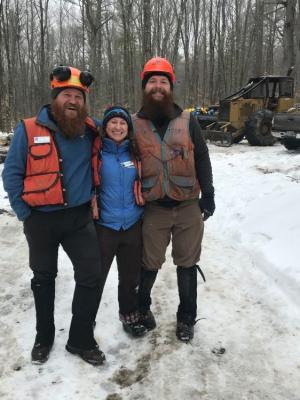
What is fundamentally different about forestry compared to farming is we don’t literally eat wood. But our domestic daily consumption of forest products ranges from lumber, millwork, paper, cardboard, cellulose, fiber, cordwood heat, biomass energy from wood-fired generators and wood pellets for home heating. Local wood may not engender the same warm and fuzzy feeling as buying veggies at the local farmer’s market… but it should!
Fact is: Northern New England is one of the finest wood-growing regions on Earth! We consume wood every day. Those who would rather not see logging in New Hampshire are merely exporting their daily demands for forest products to another region of the world we don’t necessarily see. Often, imported overseas timber is harvested without the forethought, planning, care and environmental regulations applied right in our own backyards. Local wood, local good.
Timber harvesting ensures that privately-owned forests remain economically viable. Sustainable timber harvesting allows private landowners who own nearly 80% of all the forestland in NH to continue growing trees that create jobs. Periodic forest management income allows landowners to pay property taxes. Timber harvest tax revenues benefit local towns. The forest products industry in NH provides 2.3 billion dollars in annual revenues and employs nearly 10,000 workers in forest-related industries including equipment, logging, trucking, sawmills and pulp and paper industries.
Logging tours have proven to be a good way to engender greater public understanding and support for NH forestry. Thus far, field trips to watch trees grow haven’t proven quite so popular.
